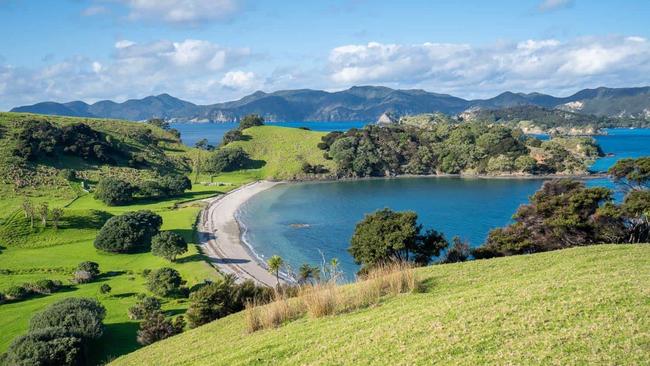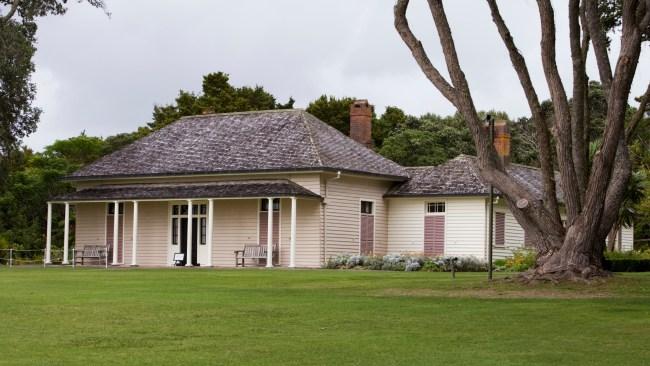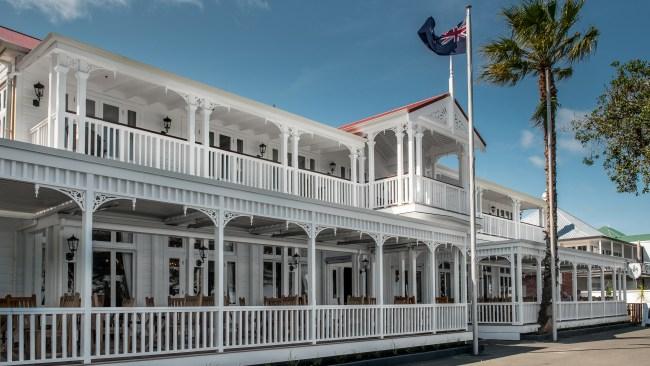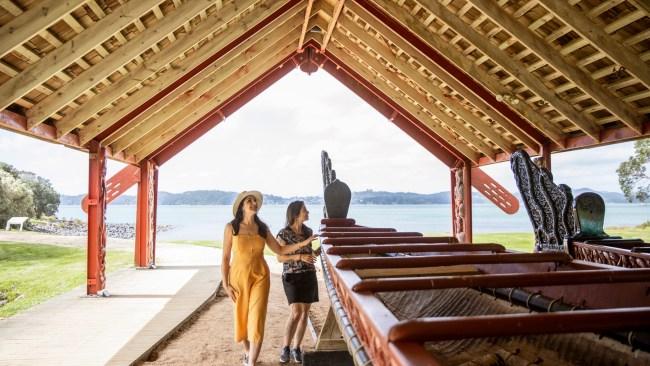I went to the “hellhole of the Pacific”, and loved it
Taitokerau Northland is brimming with bloody, fascinating history.

Lifestyle
Don't miss out on the headlines from Lifestyle. Followed categories will be added to My News.
Three flags flutter in the breeze atop a white  flagstaff, stark against a cobalt sky. Beyond  the wide green lawn, the land slopes down to a sparkling bay once alive with sailing ships  bound for the peninsula opposite,  Kororareka, then known as the “hellhole of  the Pacific” for its brawling, drinking and lawlessness. Three and a half hours’ drive north of Auckland I’m discovering deep layers of history in a place where the past is never far away.
In the grounds of the Waitangi Treaty House, the flagstaff marks the spot where the treaty that would shape the nation was signed on February 6, 1840. The flags flying are the first three official flags under which New Zealanders lived: the Flag of the United Tribes of New Zealand, first flown in 1834, the Union Flag which replaced it in 1840 and the contemporary New Zealand flag, introduced in 1902.
Our tour guide, Mukai Hura, points out another flagstaff, high on a hill across the inlet and tells the tale of Hone Heke, the first of the 40 chiefs to sign the treaty between Māori and Pākehā (Europeans) and who later gained legendary status when he and his warriors cut down the flagstaff – four times.
I could spend hours in Waitangi. As well as the Treaty House, there’s the contemporary Te Kongahu Museum of Waitangi and the Te Rau Aroha Museum of the Price of Citizenship, the elaborately carved meeting house Te Whare Runanga, the world’s largest ceremonial waka (canoe), and a cafe.
The 12-tonne, 35m waka, built for 80 paddlers, hits the water every year as part of Waitangi Day commemorations. It was carved “in the days when everything was provided by nature”, says Mukai, who was born and raised here and has a deep connection to this land.
The new Te Rau Aroha Museum of the Price of Citizenship is dedicated to the memory of Māori who served in the New Zealand armed forces. Its focus is on the Māori Pioneer Battalion in World War I and the 28th (Māori) Battalion of World War II, in particular A Company, most of whose members came from this region, Taitokerau Northland. The gallery walls are covered with photographs and names of the hundreds of young men, a moving tribute to their service.

Displays in the Te Kongahu Museum of Waitangi walk visitors through the history of the treaty, and pull no punches in presenting conflicting views from ordinary New Zealanders about its relevance to modern Kiwi life. While some see it as a uniting force, others see “lands gone, the power of chiefs humbled, Māori culture scattered and broken…” It’s thought-provoking stuff.
Leaving Waitangi, I drive through the Bay of Islands tourist hub of Paihia and on to Opua – less than 15 minutes away – to take the 10-minute car ferry to Kororareka/Russell.
The seaside township gained its name, Māori legend tells, from a chief wounded in battle who asked for a broth of “sweet penguin” to restore him. In 1844, the hamlet of Okiato, where today’s car ferry lands, was renamed after the British Colonial Secretary Lord John Russell and declared New Zealand’s first capital, a status it held for less than a year.
Most of the town’s commerce is – as it has been since the 19th century – along the curve of Kororareka Bay. Although it’s not my first time in Kororareka/Russell, I’m captivated all over again. While tourism is the main business, it has retained its laid-back charm and within hours I’m feeling as if I’ve been here for a week.

On a Saturday night, the grand colonial Duke of Marlborough hotel kicks off, its wedding-cake façade opening up to lolly-pink interiors. The walls are adorned with historic photos and a large trophy marlin hangs above the bar. For the best views, take a table on the veranda to watch the sun set beyond the pohutukawa trees and the wharf.
Waitstaff at The Duke wear shirts declaring boldly “Refreshing rascals and reprobates since 1827”. It’s a fair bet that today’s patrons are better behaved – the early Europeans were a rough mix of deserting sailors, whalers, escaped convicts and sly-grog runners, alongside more respectable traders and their families.
I can’t go past the thick seafood chowder, but I’m intrigued by my companion’s “boil up”, a mix of mutton bird, pork, kumara, potato and fried bread. It’s “hangi food” with restaurant finesse.

Further along the esplanade is Pompallier Mission and Printery, where French Catholic missionaries led by Bishop Pompallier printed 40,000 leather-bound prayer books in Māori to further their cause. Guided tours give entry to the printery and house. The impressive 1842 French-style building, made of rammed earth and timber, is surrounded by landscaped gardens, but I prefer the bush trail up the hill behind the house for views across the bay.
A walk along the esplanade reveals more history. An old cannon facing across the water to Waitangi first arrived here in 1840 and was used in the 1845 Battle of Kororareka when Hone Heke showed his disillusionment with the treaty.
New Zealand’s oldest surviving church, built in 1835, still bears witness to the conflict, with bullet holes easy to spot in its wooden walls. Inside the modest Christ Church, a Māori-English bible sits open on the lectern.

The church graveyard deserves a slow wander. The elaborate headstones of high-ranking Ngāpuhi chief Tāmati Wāka Nene and Hannah King Letheridge, the first white woman born in New Zealand, in 1816, are on display, but there are other stories, too, like that of “dear little Alexander P McLeod, who was drowned… aged 4 years & 10 months” in 1883, his gravestone etched with a heartfelt message from grieving parents.
On a one-hour tour with Russell Mini Tours, I finally get to the top of Te Maiki/Flagstaff Hill, where Hone Heke felled the flagpole the British had relocated from Waitangi after the signing of the treaty. Why? It’s a complicated story that goes to the heart of the controversy that has long dogged the Treaty of Waitangi.
To understand it, the best way is to simply come here. Taitokerau Northland is rich in history and in stories that captivate and intrigue. Besides, as I head south again on the winding coastal road that is a slower alternative to the ferry and the highway, I reflect that there’s a lot of truth in the words of a local quoted at the small but fascinating Russell Museum: “Korororeka is not just a place, it’s a state of mind.”
The writer was assisted by Northland Inc for entry to the Waitangi Treaty House and a tour with Russell Mini Tours.
Originally published as I went to the “hellhole of the Pacific”, and loved it




